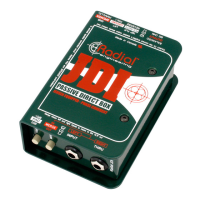Radial Engineering JDI
™
User Guide
6
The beauty of a transformer is that there is no electrical connection between the primary and the secondary. The signal is
‘transformed’ from electrical energy to magnetic, then back to electrical; in effect, a ‘magnetic bridge’. This provides two
huge benets: with no electrical path, ground loops are eliminated and when properly designed, a tremendous reduction in
common-mode noise is possible. In the ‘real world’ (not the test bench) signals are never truly balanced, leaving the door
open for noise to pollute the audio signal. Electronically balanced circuits (active circuits) are ill equipped to manage this
common mode noise, whereas the JDI provides exceptional noise rejection at 60Hz – the crest of hum and buzz.
An audio laboratory test called ‘The Green Report’ (visit www.radialeng.com for details) pitted the JDI against three other
direct boxes commonly used in professional audio. The tests showed that the JDI could handle more gain before distortion,
was more linear throughout the audio frequency range and showed signicantly less phase distortion. All boxes tested
well at 1kHz, but as the frequency dropped, the ‘ugly truth’ started to appear. One popularly used DI was almost 20º out of
phase at 20Hz while another was almost 40º out of phase! The JDI tested at less than 4º off the mark, making it the most
phase accurate DI on the planet.
With its high signal level handling, dynamic response and unmatched phase accuracy, the JDI is a signicantly better
choice for bass, keyboard and acoustic guitars with built-in pre-amps and this can be directly attributed to the quality of the
Jensen transformer we use.
Audio
Transformer
Electrical Utility
The Problem:
Ground loop formed between
connected equipment by the signal
cable and AC power cables.
Signal
Cable
Electrical Utility
AC Power
Cable
Ground
Loop
The Cure:
An audio transformer (DI box)
is introduced at the signal cable
eliminating the loop.
True to the Music

